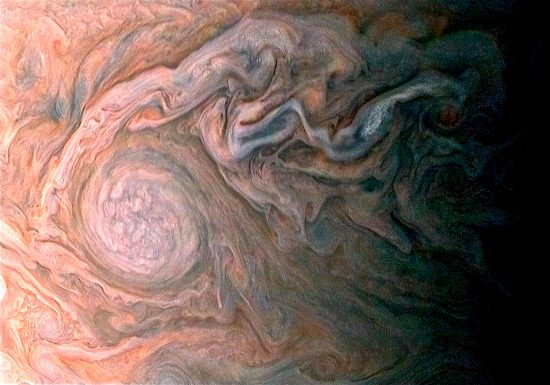
Close-up view of Jupiter’s cloud tops. Credit: NASA/JPL-Caltech/SwRI/MSSS/Roman Tkachenko.
May 10, 2017
Jupiter’s electromagnetic fields are larger than predicted.
The Juno spacecraft entered orbit around Jupiter on July 4, 2016 after an August 5, 2011 launch and a five-year flight. Since there are radiation belts around Jupiter similar to the Van Allen radiation belts that surround Earth, but thousands of times greater in strength and extent, Juno’s electronics are housed within a titanium shell, so that the energetic particles trapped around Jupiter will not interfere with its systems.
Jupiter is the largest planet. It is so large that all of the other planets could fit comfortably inside its 1.77 X 10^15 cubic kilometer volume. Jupiter rotates in 9.925 hours, causing its diameter to be 9275 kilometers more than the distance between its poles.
As previously written, Jupiter’s moon Io dissipates more than 2 trillion watts as it revolves through Jupiter’s electromagnetic fields. The electric charge flow creates lightning in the planet’s upper atmosphere, as well as intense aurorae at the poles. The Hubble Space Telescope released a video of the aurorae, timed to coincide with Juno’s arrival.
Recently, mission scientists announced that Jupiter is an even more electrically active world than their models predicted. Instead of a 5 gauss magnetic field, Juno measured levels as high as 9 gauss (compared to Earth’s .5 gauss field). The field is also quite irregular, suggesting to astrophysicists that there is a nonconformity in Jupiter’s core. According to mission team member, Jack Connerney:
“Jupiter’s magnetic field is spatially complex, and there were deficits of up to 2 gauss elsewhere. We may need many more orbits to resolve this.”
Conventional theories assume that the Universe is electrically neutral, so when observations confirm electrical activity, localized phenomena are invoked. So-called “tidal forces” and volcanoes are causing the activity on Io, rather than a several million ampere charge flow between it and Jupiter. In the case of Jupiter’s rings, charges detected in the ring plane by Galileo are said to be caused by sunlight and shadow rather than by an electric circuit between Jupiter and the Sun.
Rotating charged bodies produce dipolar electromagnetic fields, whether they are gas giants or rocky planets. Why some planets like Earth and Mercury possess magnetic fields, while Venus and Mars do not demands further investigation. However, the basic physics of charged objects in motion generating electromagnetism is not debated.
An electrical interaction between Jupiter and its moons means that they are charged bodies and are not electrically neutral. Jupiter exists in a dynamic electrical relationship to the Sun, so its electromagnetic signatures are variable, changing with the Sun’s fluctuating solar cycle. Electric Universe theories are expected to be confirmed by the Juno mission.
Stephen Smith












